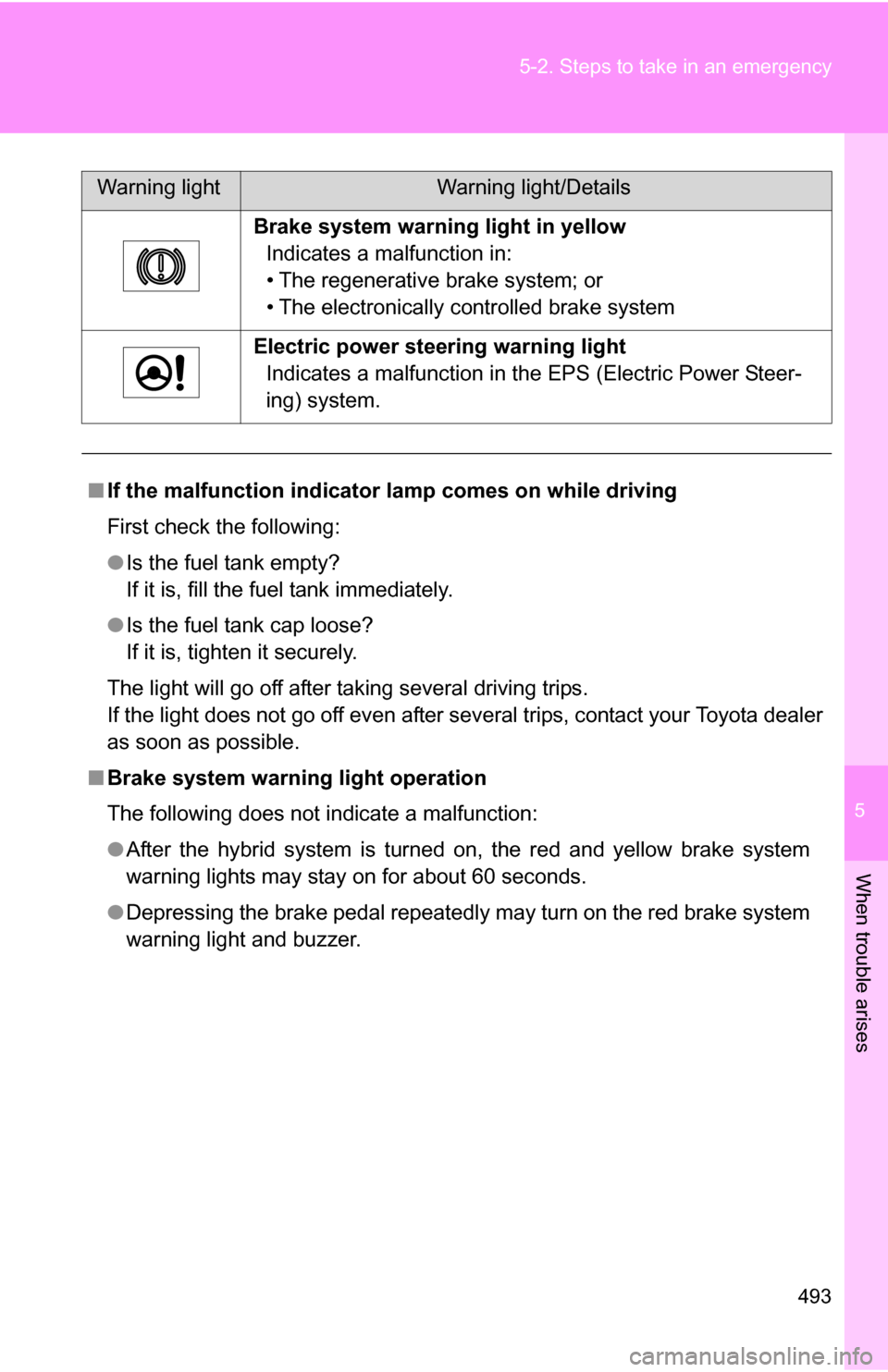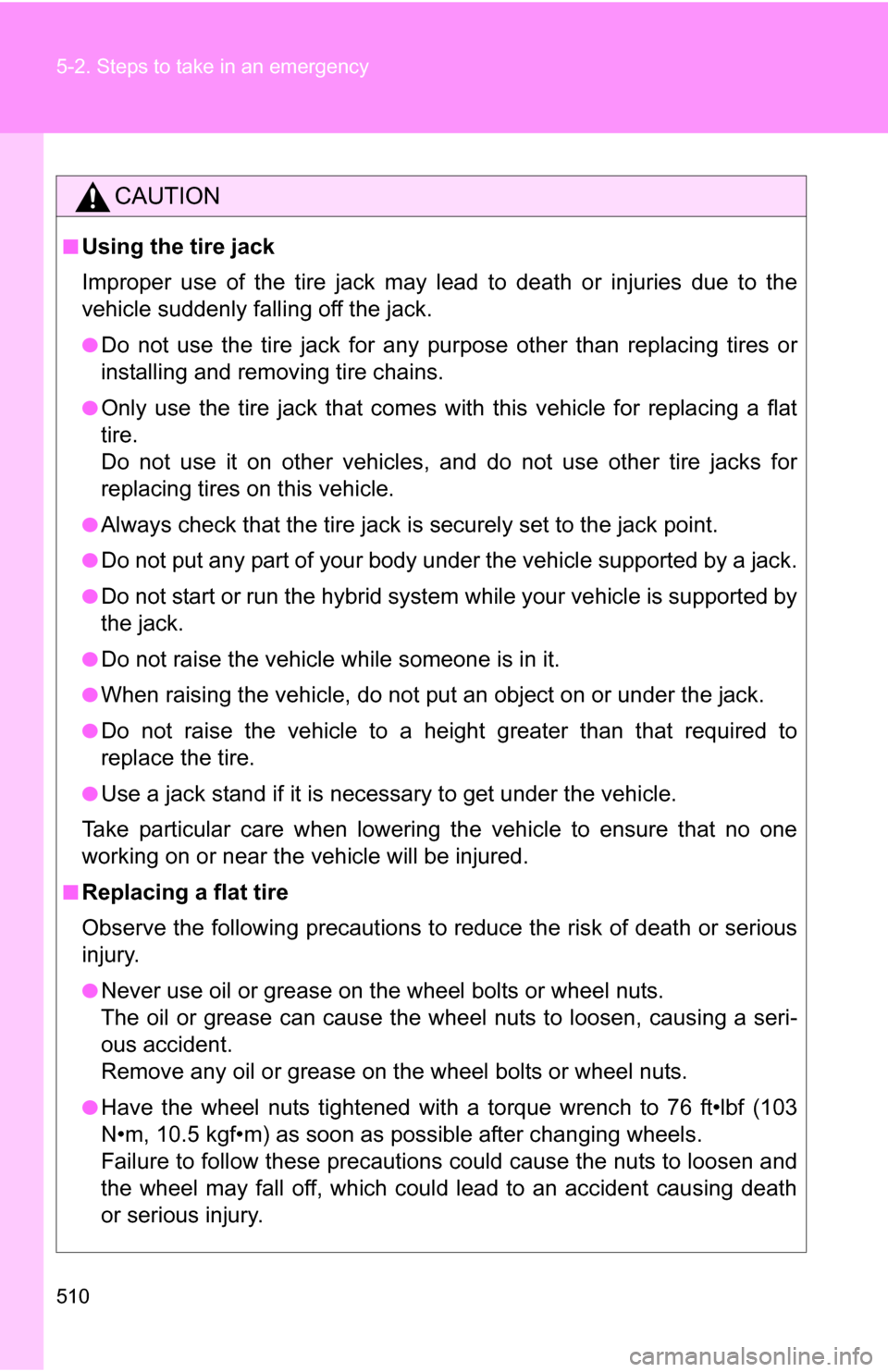Page 483 of 580

5
When trouble arises
483
5-1. Essential information
Emergency towing
If a tow truck is not available, in an emergency your vehicle may be
temporarily towed using a cable or chain secured to the emergency
towing eyelet(s). This should only be attempted on hard surfaced
roads for short distances at a speed below 18 mph (30 km/h).
A driver must be in the vehicle to steer and operate the brakes. The
vehicle’s wheels, drive train, axles, steering and brakes must be in
good condition.
Towing eyelet
■Emergency towin g procedure
Release the parking brake.
Shift the shift lever to N.
Turn the “POWER” switch to ACCESSORY mode (hybrid system
off) or ON mode (hybrid system operating).
CAUTION
■ Caution while towing
●Use extreme caution when towing the vehicle.
Avoid sudden starts or erratic driving maneuvers which place excessive
stress on the emergency towing eyelet and the cables or chains.
● If the hybrid system is off, the power assist for the brakes and steering will
not function, making steering and braking more difficult.
STEP1
STEP2
STEP3
Page 484 of 580
484 5-1. Essential information
Installing towing eyeletRemove the eyelet cover while
pushing it.
Insert the towing eyelet into the
hole and tighten partially by
hand.
Tighten down the towing eyelet
securely using a wheel nut
wrench.
NOTICE
■To prevent causing serious dama ge to the transmission
Never tow this vehicle from the rear with the front wheels on the ground.
This may cause serious damage to the transmission.
STEP1
STEP2
STEP3
Page 485 of 580
5
When trouble arises
485
5-1. Essential information
■
Location of the emer gency towing eyelet
P. 501
CAUTION
■ Installing towing eyelet to the vehicle
Make sure that towing eyelet is installed securely.
If not securely installed, towing eyelet may come loose during towing. This
may lead to accidents that cause serious injury or even death.
Page 489 of 580

5
When trouble arises
489
5-1. Essential information
Event data recorder
In a crash or a near car crash eventThe SRS airbag sensor assembly contains the EDR. In a crash or a
near car crash event, this device may record some or all of the follow-
ing information:
● Gasoline engine speed
● Whether the brake pedal was depressed or not
● Vehicle speed
● To what extent the accelerator pedal was depressed
● Position of the transmission shift lever
● Whether the driver and front passenger wore seat belts or not
● Driver's seat position
● Front passenger's occupant classification
● SRS airbag deployment data
● SRS airbag system diagnostic data
If your vehicles is equipped with a vehicle stability control (VSC) system
The VSC Electronic Control Unit (ECU) may contain another EDR. In
case the VSC or Brake Assist syst em is activated, or the lateral
acceleration is beyond a certain value, this device may record some
or all of the following information:
Your vehicle has computers that monitor and control certain aspects
of your vehicle. These computers assi st in driving and maintaining
optimal vehicle performance.
Besides storing data useful for tr oubleshooting, there is an event
data recorder (EDR) that records data in a crash or a near car
crash event.
Page 490 of 580

490 5-1. Essential information
●Behavior of the vehicle
● Steering wheel angle
● Vehicle speed
● To what extent the accelerator pedal was depressed
● To what extent the brake pedal was depressed
● To what extent the ECU controlled the condition of the 4 wheels
● Vehicle stability contro l system diagnostic data
The information above is intended to be used for the purpose of
improving vehicle safety performan ce. Unlike general data recorders,
the EDR does not record sound data such as conversation between
passengers.
Disclosure of the data
Toyota will not disclose the data re corded in an EDR to a third party
except when:
● An agreement from the vehicle's owner (or the leasing company for
a leased vehicle) is obtained
● Officially requested by the police or other authorities
● Used as a defense for Toyota in a law suit
● Ordered by a court law
However, if necessary Toyota will:
● Use the data for research on Toyota vehicle safety performance
● Disclose the data to a third party for research purposes without dis-
closing details of the vehicle owner, and only when it is deemed
necessary
● Disclose summarized data cleared of vehicle identification informa-
tion to a non-Toyota organization for research purposes
Page 493 of 580

5
When trouble arises
493
5-2. Steps to take in an emergency
Brake system warning light in yellow
Indicates a malfunction in:
• The regenerative brake system; or
• The electronically controlled brake system
Electric power steering warning light Indicates a malfunction in the EPS (Electric Power Steer-
ing) system.
■ If the malfunction indicator lamp comes on while driving
First check the following:
● Is the fuel tank empty?
If it is, fill the fuel tank immediately.
● Is the fuel tank cap loose?
If it is, tighten it securely.
The light will go off after taking several driving trips.
If the light does not go off even after several trips, contact your Toyota dealer
as soon as possible.
■ Brake system warning light operation
The following does not indicate a malfunction:
●After the hybrid system is turned on, the red and yellow brake system
warning lights may stay on for about 60 seconds.
● Depressing the brake pedal repeatedly may turn on the red brake system
warning light and buzzer.
Warning lightWarning light/Details
Page 502 of 580
502 5-2. Steps to take in an emergency
Taking out the jackRemove the right side deck
board.
Unhook the tightening strap and
remove the pad.
After storing the jack, make
sure it is securely held by the
tightening strap.
Loosen
Tighten
STEP1
STEP2
STEP3
Page 510 of 580

510 5-2. Steps to take in an emergency
CAUTION
■Using the tire jack
Improper use of the tire jack may lead to death or injuries due to the
vehicle suddenly falling off the jack.
●Do not use the tire jack for any pu rpose other than replacing tires or
installing and removing tire chains.
●Only use the tire jack that comes with this vehicle for replacing a flat
tire.
Do not use it on other vehicles, and do not use other tire jacks for
replacing tires on this vehicle.
●Always check that the tire jack is securely set to the jack point.
●Do not put any part of your body under the vehicle supported by a jack.
●Do not start or run the hybrid system while your vehicle is supported by
the jack.
●Do not raise the vehicle while someone is in it.
●When raising the vehicle, do not put an object on or under the jack.
●Do not raise the vehicle to a hei ght greater than that required to
replace the tire.
●Use a jack stand if it is necessary to get under the vehicle.
Take particular care when lowering the vehicle to ensure that no one
working on or near the vehicle will be injured.
■Replacing a flat tire
Observe the following precautions to reduce the risk of death or serious
injury.
●Never use oil or grease on the wheel bolts or wheel nuts.
The oil or grease can cause the wheel nuts to loosen, causing a seri-
ous accident.
Remove any oil or grease on the wheel bolts or wheel nuts.
●Have the wheel nuts tightened with a torque wrench to 76 ft•lbf (103
N•m, 10.5 kgf•m) as soon as possible after changing wheels.
Failure to follow these precautions could cause the nuts to loosen and
the wheel may fall off, which could lead to an accident causing death
or serious injury.